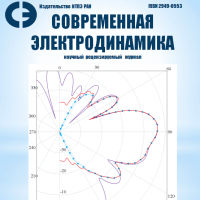
Message from the Editor-in-Chief
Section 1. Topics on theoretical electrodynamics
Magic radius of AA bilayer graphene quantum dot
Sboychakov A. O., Rozhkov A. V., Rakhmanov A. A.
The paper investigates the electronic properties of a quantum dot made of AA bilayer graphene of round shape. A discrete set of point radii is observed at which low-energy electronic states are degenerate with respect to the parity of the wave function with respect to the permutation of layers. By analogy with the "magic angles" in twisted bilayer graphene, we call these radii "magic". This feature is unique for AA structures and is associated with the specific layer symmetry of the AA bilayer graphene: the parity of the highest occupied energy level changes from symmetric in the layer index to antisymmetric when the radius of the AA dot is equal to its magic value. The analogy in the electronic structure between twisted bilayer graphene with a magic twist angle and the quantum dot of AA bilayer graphene with a magic radius is investigated. This analogy can be useful for the theoretical description of the electronic properties of twisted bilayer graphene.
Key words: Bilayergraphene, electronic structure, quantum dot
Section 2. Topics on experimental electrodynamics
Tunable electromagnetic screen for centimeter wavelength based on vanadium dioxide thin films
Polozov V. I., Maklakov S. S., Maklakov S. A., Naboko A. S., Baskov K. M., Petrov D. A., Kisel V. N.
A new design of a tunable electromagnetic screen (ES) for centimeter wavelength based on V02 thin film is demonstrated. Arectangular slot metallic ES formed on a functional V02 thin film is described. A frequency response of the resulting structure can be thermally tuned. The tuning is based on asharp change of conductivity of the V02 film, caused by heating from room temperature to a temperature of the metal-insulator phase transition of 45 °C. A tuning mechanism of the ES allows continuous change of frequency response from a room temperature state, where the ES acts as a band-pass filter with 10 GHz bandwidth, to a high-temperature state, where the ES works as a reflector. In the process of tuning, a transmission coefficient at a central frequency of the filter of 14 GHz can be lowered from -0,9 dB down to -10,1 dB. The proposed approach can be used for the design of tunable ES for applications that allow thermal control of the frequency response. Both layers of the tunable ES are synthesized using magnetron sputtering that ensures an ease of scaling of the ES production.
Key words: vanadium dioxide, thin films, metal-insulator transition, RF electromagnetic screen, tunable RF devices
Section 3. Topics on computer simulation in electrodynamics
SIMULATION OF A BISTATIC BODY SCATTERING DIAGRAM BASED ON ELECTROMAGNETIC NEAR-FIELD DATA ON A PLANE
Balabukha N. P., Konyaev D. A., Shapkina N. E.
Near-field to far-field transformation is analyzed when measuring on a flat scanning surface is realized strictly taking into account that scanning surface is truncated. The paper proposes an adaptation of the method presented in [1] - [4] for the case of near-field scanning on a plane in the vector case. Numerical simulation was carried out using the proposed method, and compared with results obtained by the traditional method, in which the field outside the scan area is assumed to be zero. The tests were carried out using an perfectly conducting cylinder as a scatterer, the cylinder dimensions are close to the wavelength of the incident radiation. Calculations have shown that, despite rigorous accounting of scanning surface truncation, the method gives results very close to those of the traditional method. The latter circumstance, supplemented by the need for the correct selection of parameters and increased requirements for computing resources, makes the traditional method preferable.
Key words: bistatic RCS, near-field to far-field transformation, near-field scanning, planar scanner, electromagnetic waves scattering
Baskov К. М., Semenenko V. N., Furmanova T. A., Chistyaev V. A.
The article present same thod for suppressing the Gibbseffect, whichis observed during digital processing by the Time Domain method of measurement results of S-parameters of various samples of materials and leads to significant measurement errors. The method is based on the introduction of a pre-distortion function in to the processed signal, as a result of which the processed signal is significantly shortened in the time domain, which significantly reduces the measurement errors associated with the Gibbs effect in the windowed Fourier transform of functions with discontinuity. Two variant softhepre-distortion functionare presented - a linear function and a function in the form of a moving average. The effectiveness of the application of the linear function of pre-distortion has been demonstrated both numerically and experimentally. It is shown that if a narrow-band resonance exists in a true signal, then its time spectrum turns out to be very long, which leads to an increase in the Gibbs effect during signal processing of the signal, and the linear pre-distortion function does not allow it to be fully suppressed. Using mathematical modeling, it is shown that the function of pre-distortion in the form of a moving average can significantly increase the accuracy of restoring the true signal in which a narrow-band signal is observed.
Key words: Time Domain, Gibbs Effect, Transmission Coefficient, Reflection Coefficient, S Parameters, Fourier Transform
CREATING OF SAMPLE STRUCTURES TO INCREASE THE ACCURACY OF MEASUREMENTS OF THE SPECULAR REFLECTION COEFFICIENT
Gilmutdinov R. V., Menshikh N. L., Fedorov S. A., Balabukha N. P.
In this paper, the effect of different structures of flat material samples on the methodological error of substitution methods in the bistatic statement are compared when measuring the specular reflection coefficient (|R|) and the Brewster angle. The Structures are a sample, the edges and the back side of which are covered with radar absorbing materials. The method of moments in the FEKO program was used to study structures based on a material of model magnetodielectrics with frequency-independent parameters of the medium. The results of |R| are compared with each other and with the results of calculations using the Fresnel formulas, carried out in the study of an infinite flat layer of material. By calculating the effects of experiments, it is shown that the use of Structures makes it possible to reduce the influence of edges and increase the measurement accuracy, including the minimum |R| at the Brewster angle. The types of structures that reduce both primary and secondary diffraction are distinguished. The influence of edges was studied on the observed diffraction effects. The use of the structures presented in the work makes it possible to reduce the influence of diffraction effects on all operating frequencies and angular manifestations. The conclusions about the advantages of structures obtained in this work are applicable to extensive lossy magnetodielectric materials.
Key words: bistatic measurements, edge effects, reflection coefficient, method of moments, FEKO
Section 4. Topics on interaction of an electromagnetic field with materials
WAVE MIXING ON A SINGLE QUBIT: EFFECTS OF PHOTON STATISTICS
Pogosov W. V., Dmitriev A. Yu., Astafiev O. V.
A theoretical study is presented of the wave mixing when a single superconducting qubit is irradiated by two photon fields. The first signal is a classical monochromatic signal (pump), and the second is a non-classical light. In particular, we consider two examples of non-classical light: (1) broadband squeezed light, which can be generated by a degenerate parametric amplifier, and (2) a periodically excited quantum superposition of Fock states with 0 and 1 photons, which can be generated by a source of single photons (source qubit ) upon pumping it with the appropriate pulses. It is shown that the mixing of classical and nonclassical photon fields leads to the appearance of side peaks in the scattered radiation due to elastic multiphoton scattering on the probe qubit, which acts as a nonlinear element. It is demonstrated that the structure of the side peaks is qualitatively different from the situation when two classical monochromatic signals with slightly different frequencies are mixed. The most interesting feature is the absence of some side peaks corresponding to individual multiphoton processes, which turn out to be impossible due to the peculiarities of the incident wave statistics. A general conclusion is drawn that the analysis of peak amplitudes can be used to study the statistics of photons in a nonclassical mode, which can potentially find application in quantum sensorics.
Key words: qubit, photon, nonlinear optical processes, wave mixing, quantum statistics

Editorial address: 13 b. 6, Izhorskaya st.,
This site respects your rights and maintains confidentiality when filling out, transmitting and storing your confidential information.
Placing an application on this site means your consent to the processing of data and the further transfer of your contact information to our company.
Personal data means information related to the subject of personal data, in particular the name, contact details (email address) and other data classified as personal data by Federal Law of July 27, 2006 No. 152-FZ “On Personal Data.”
The purpose of processing personal data is to inform about the services provided by our company.
